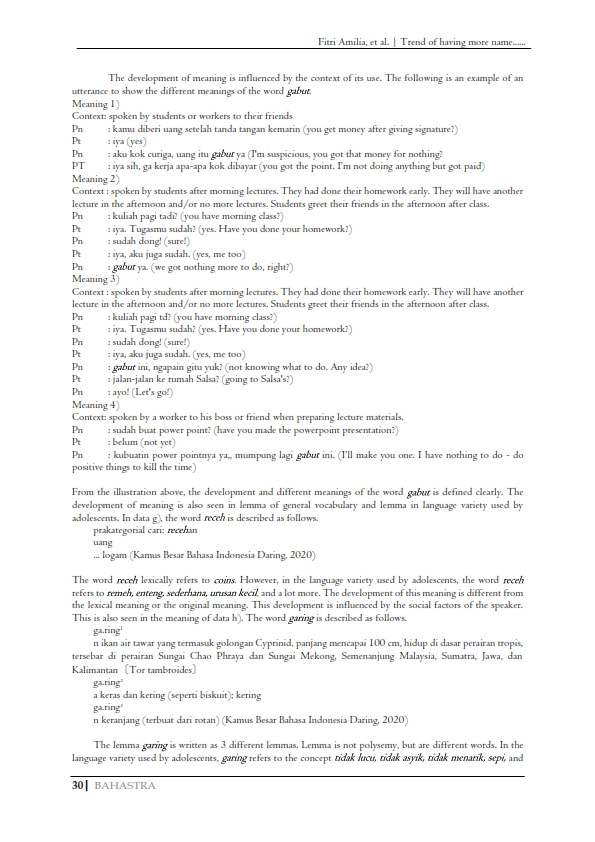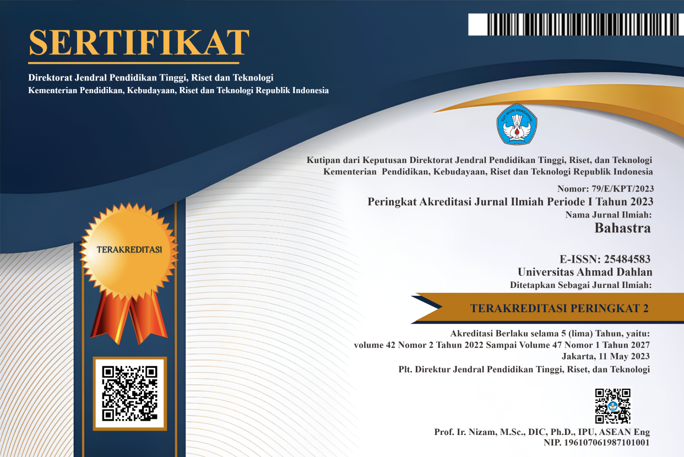The development of lemma and meaning in the language variety used by adolescents on social media
DOI:
https://doi.org/10.26555/bs.v42i1.33Keywords:
Lemma, Social media, The development of lemma, Language varietyAbstract
This study examines the natural phenomena on the development of lemma and meaning in the variety of languages used by adolescents on social media. Research design was done naturally through the process of observation, taking notes, and writing down the case. The qualitative research appears in the development of the entry which is easily found as a definite phenomenon of linguistic development. The data collection method was carried out by tracing data on the use of various languages on social media. To analyze the data, the researcher uses padan and agih methods. This method is to test the accuracy of classification on the types of language used by adolescents in social media in the development of the entry and or the development of the meaning of the entry. The results showed that the variety of languages on social media is very dynamic, developing, arbitrary, but conventional. The variety of languages indicates the development of new lemmas, acronyms, and walikan. The development of meaning is marked along with the development of the entry in the form of synonyms and the use of the Indonesian language entry in the form of a polysemic. Based on the results of this study, adolescents can be considered a productive period in exploring the language, through direct interaction or social media. Becoming actively productive in language exploration led to a potential for concepting a new lemma and a new meaning according to the context of language use. In addition, this development becomes one proof of the self-existence of adolescence, community characteristics, and also the need for the development of Indonesian vocabulary.
References
Anugrahadi, S. (2019). Mengenal Remaja Generasi Z (Dalam Rangka memperingati Hari Remaja Internasional). Perwakilan Badan Kependudukan Dan Keluarga Berencana Provinsi NTB (9 Oktober 2019). Https://Ntb. Bkkbn. Go. Id.
Badan Pengembangan dan Pembinaan Bahasa. (2003). Kamus Besar Bahasa Indonesia Edisi Ketiga. Jakarta: Balai Pustaka.
Badan Pengembangan dan Pembinaan Bahasa. (2020, April 18). https://kbbi.kemdikbud.go.id/. Diambil kembali dari https://kbbi.kemdikbud.go.id/Beranda:
Badan Pengembangan dan Pembinaan Bahasa. (2007). Pedoman Umum Pembentukan Istilah. Jakarta: Departemen Pendidikan dan Kebudayaan.
Breivik, L. E., & Jahr, E. H. (2011). Language change: contributions to the study of its causes (Vol. 43). Walter de Gruyter.
Budiwiyanto, A. (2016). Pendokumentasian bahasa dalam upaya revitalisasi bahasa daerah yang terancam punah di Indonesia. Diakses Dari: Http://Badanbahasa.Kemdikbud.Go. Id/Lamanbahasa/Artikel/1823/Pendokumentasian-Bahasa-Dalam-Upaya-Revitalisasi-Bahasa-Daerah-Yang-Terancam-Punah-Di-i.
Chaer, A. (2003). Linguistik umum. Jakarta: Rineka Cipta
Coleman, J. (2017). The life of slang. In Journal of Chemical Information and Modeling (Vol. 53, Issue 9).
Darheni, N. (2011). Dinamika perkembangan kosakata bahasa Indonesia ditinjau dari aspek pemaknaan jurnal sosioteknologi edisi 23 tahun 10, agustus 2011 1117 dinamika perkembangan kosakata bahasa indonesia ditinjau dari aspek pemaknaan. Jurnal Sosioteknologi, 10 (23), 1117–1128.
Debot, K., Paribakht, T. S., & Wesche, M. B. (1997). Toward a lexical processing model for the study of second language vocabulary acquisition: Evidence from ESL reading. Studies in Second Language Acquisition, 309–329.
Departemen Pendidikan dan Kebudayaan RI. (1988). Kamus Besar Bahasa Indonesia. Jakarta: Balai Pustaka.
Djajasudarma, T. (1993). Semantik 1. pengantar ke arah ilmu makna. Bandung: PT. Eresco.
Drake, G. F. (1980). The social role of slang. In Language. https://doi.org/10.1016/b978-0-08-024696-3.50015-6
Ellis, N. C. (2008). The dynamics of second language emergence: cycles of language use, language change, and language acquisition. Modern Language Journal, 92(2). https://doi.org/10.1111/j.1540-4781.2008.00716.x
Ertika, R., Chandra W., D. E., & Diani, I. (2019). Ragam bahasa gaul kalangan remaja di kota Bengkulu. Jurnal Ilmiah KORPUS, 3(1). https://doi.org/10.33369/jik.v3i1.7349
Espree-Conaway, D. (2012). Language Attitudes, Acquisition, and Usage of Osob Kiwalan Ngalam: An Indo-Javanese Language of Malang.
Fasola, J. (2012). Slang and its history. Proceedings of the 53rd International Scientific Conference of Daugavpils University.
Halliday, M. A. K. (1987). Spoken and written modes of meaning. In Comprehending oral and written language.
Halliday, M. A. K. (2002). Spoken and written modes of meaning (1987). In On grammar.
Halliday, M. A. K., & Hasan, K. (2014). Cohesion in English. In Cohesion in English. https://doi.org/10.4324/9781315836010
Hoogervorst, T. G. (2013). Youth culture and urban pride The sociolinguistics of East Javanese slang. Wacana, Journal of the Humanities of Indonesia, 15(1). https://doi.org/10.17510/wjhi.v15i1.107
Inayatillah, F. (2018). Perkembangan kosakata dalam buku siswa bahasa Indonesia untuk sekolah menengah. Prosiding Semnas PPM 2018, 1(1), 485–489.
Leech, G. (2003). Semantik (Buku diterjemahkan oleh Paina Partana). Yogyakarta: Pustaka Pelajar.
Mattiello, E. (2008). An introduction to English slang: a description of its morphology semantics and sociology. In International Migration (Vol. 2).
Myers-Scotton, C. (2011). The matrix language frame model: developments and responses. In Codeswitching Worldwide, Bd. II. https://doi.org/10.1515/9783110808742.23
Parera, J. D. (2004). Teori semantik [Semantic theory]. Jakarta: Erlangga.
Peng, J. E. (2011). Changes in language learning beliefs during a transition to tertiary study: the mediation of classroom affordances. System, 39 (3). https://doi.org/10.1016/j.system.2011.07.004
Poulisse, N. (1997). Language production in bilinguals. Tutorials in Bilingualism: Psycholinguistic Perspectives, 201–224.
Poulisse, N., & Bongaerts, T. (1994). First language use in second language production. Applied Linguistics, 15(1). https://doi.org/10.1093/applin/15.1.36
Pradopo, R. D. (1997). Ragam bahasa sastra. Humaniora, 97(4).
Prastyo, A. B., & Sodiq, S. (2021). Perkembangan kosakata pemelajar sekolah dasar. Jurnal Education And Development, 9(2), 225–231.
Setyanto, A. (2016). Osob ngalaman (bahasa slang asal Malang) sebagai salah satu i-con Malang (studi struktur osob ngalaman, dalam sosial network). Jurnal Pariwisata Pesona, 1(1). https://doi.org/10.26905/jpp.v1i1.375
Sumarsono, & Partana, P. (2007). Sosiolinguistik. Sabda bekerjasama dengan Pustaka Pelajar.
Thomson, R. (2004). 'An Adult Thing'? Young People's Perspectives on the Heterosexual Age of Consent. Sexualities, 7(2). https://doi.org/10.1177/1363460704042160
Tong, H. K., & Cheung, L. H. (2011). Cultural identity and language: A proposed framework for cultural globalisation and glocalisation. Journal of Multilingual and Multicultural Development, 32(1), 55–69.
Ulfah, L. N. (2021). Penggunaan ragam bahasa remaja milenial di kota Malang. Jurnal Penelitian, Pendidikan, Dan Pembelajaran, 16(24).
Ulmann, S. (2007). Pengantar semantik (Terjemahan Sumarsono). Yogyakarta: Pustaka Pelajar.
Verhoeven, L. T. (1994). Functional literacy : Theoretical issues and educational implications. In Studies in Written Language and Literacy v. 1.
Wijana, I. D. P. (2012). The use of English in Indonesian adolescent'S slang. Humaniora, 24(3).
Wiratno, T., & Santosa, R. (2014). Pengantar linguistik umum. Modul Pengantar Linguistik Umum.
Yannuar, N., Iragiliati, E., & Zen, E. L. (2017). Bòsò walikan Malang's address practices. GEMA Online Journal of Language Studies, 17(1). https://doi.org/10.17576/gema-2017-1701-07
Yannuar, N., Klamer, M. A. F., & Hoogervorst, T. G. (2020). Bòsò walikan malangan structure and development of a javanese reversed language. Wacana, 21(1). https://doi.org/10.17510/WACANA.V21I1.879
Zhou, Y., & Fan, Y. (2013). A sociolinguistic study of American slang. Theory and Practice in Language Studies, 3(12). https://doi.org/10.4304/tpls.3.12.2209-2213

Downloads
Published
Issue
Section
License
Copyright (c) 2022 Fitri Amilia, Indah Werdiningsih, Rohmat Tri Aditiawan

This work is licensed under a Creative Commons Attribution-ShareAlike 4.0 International License.

1.jpg)






